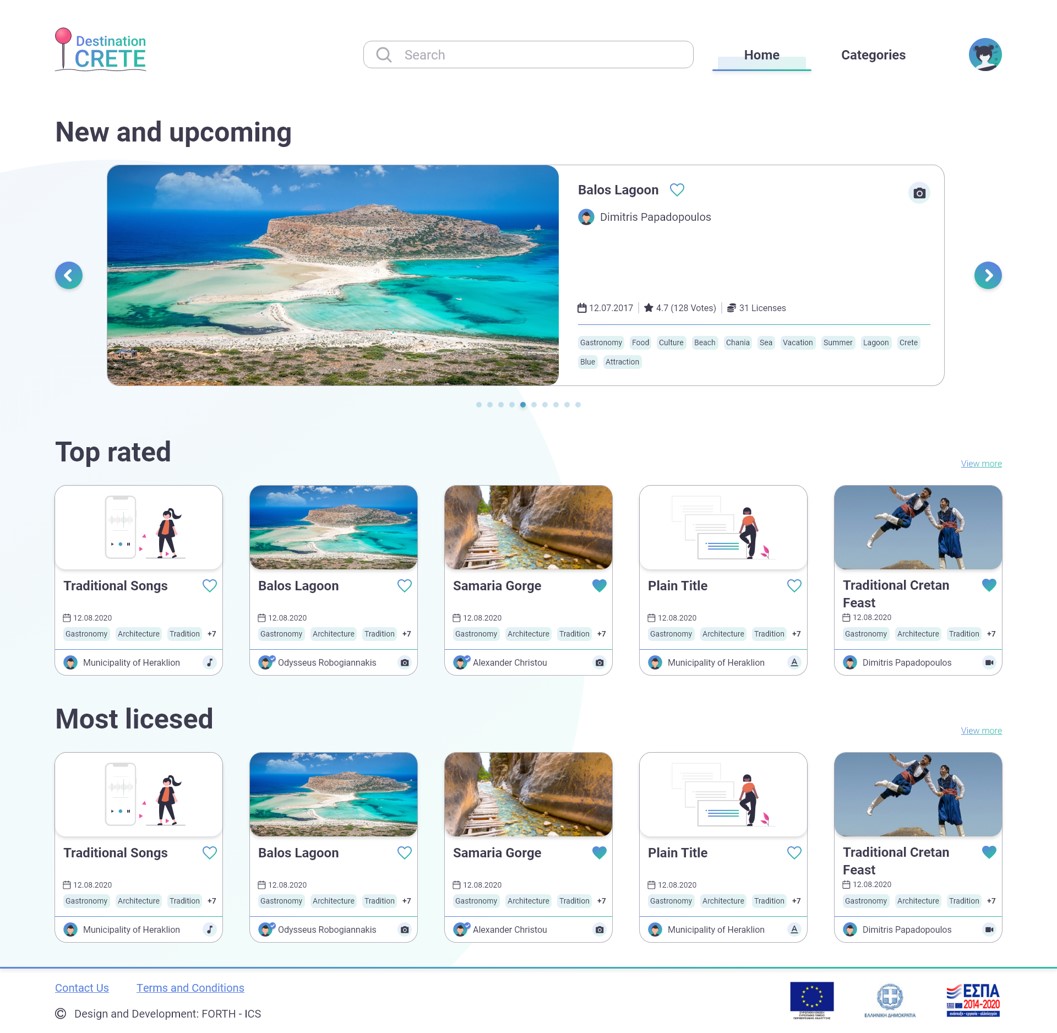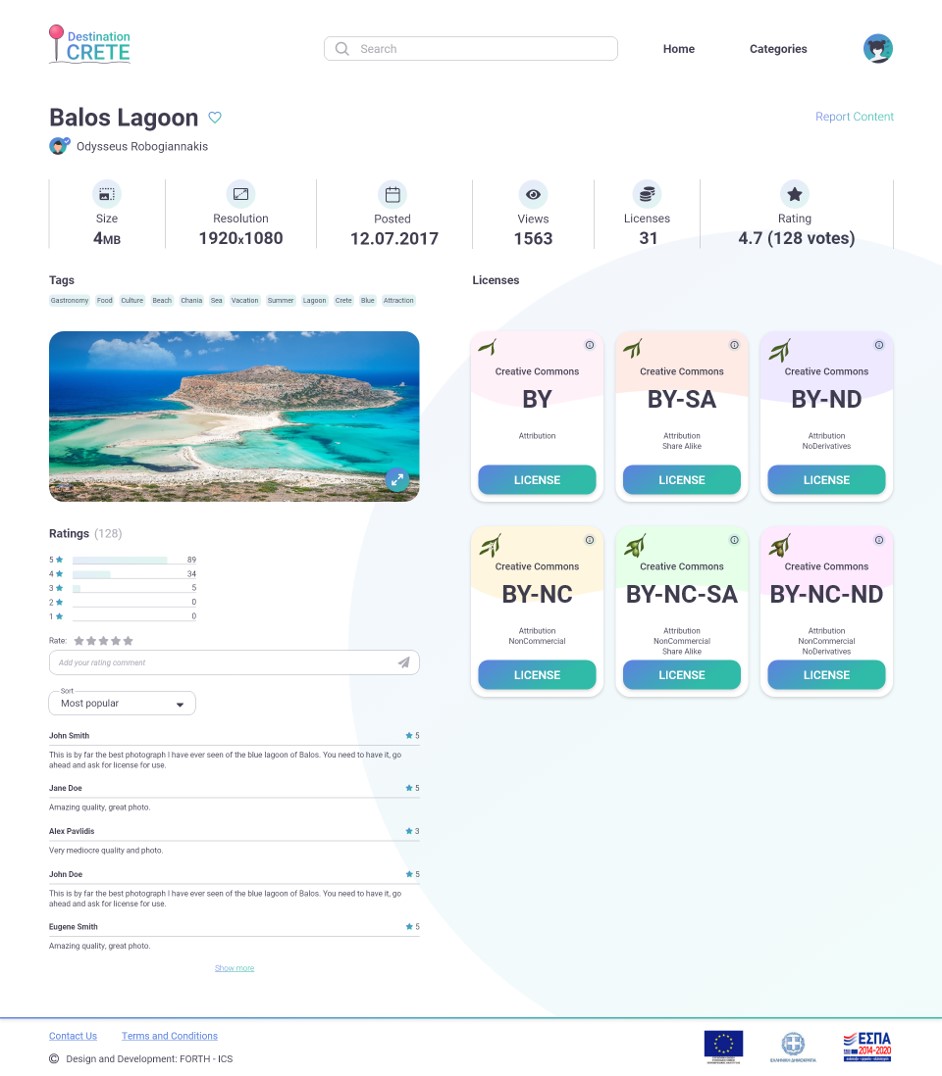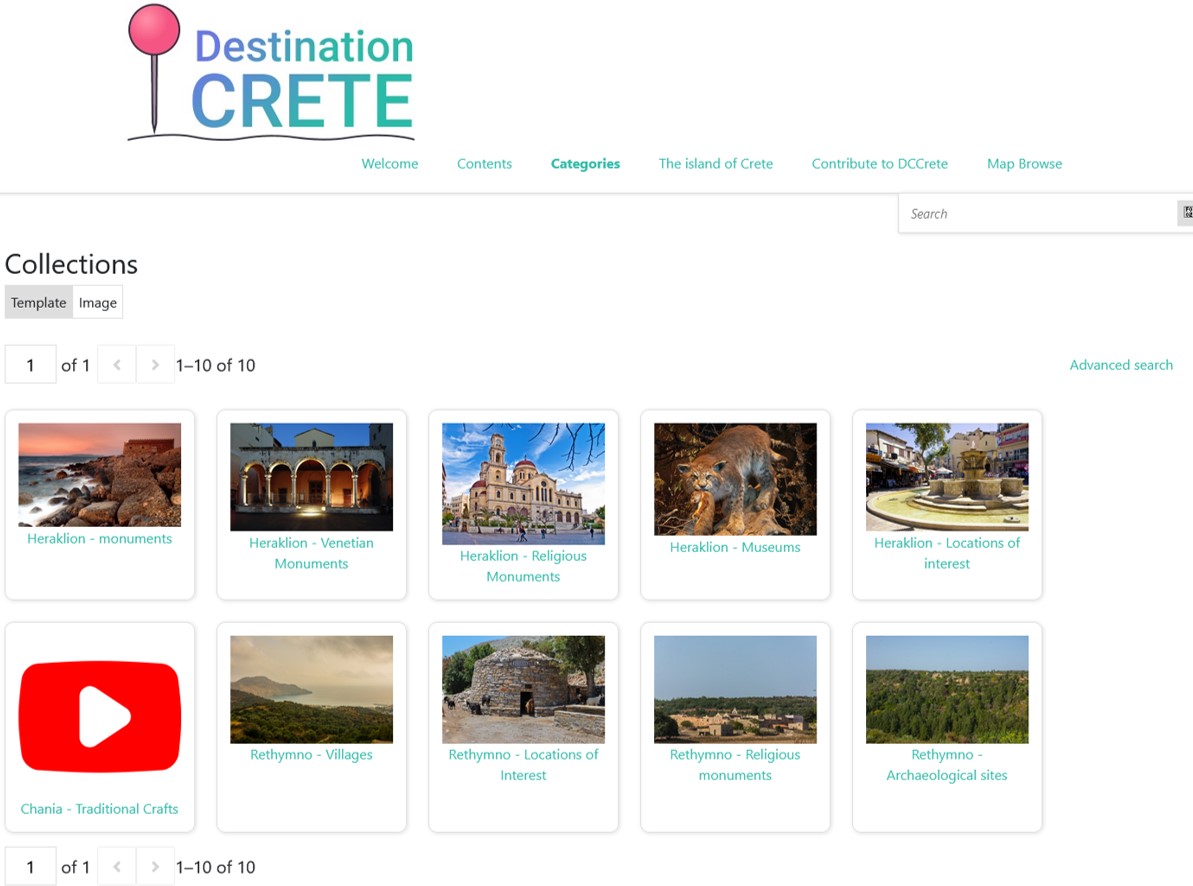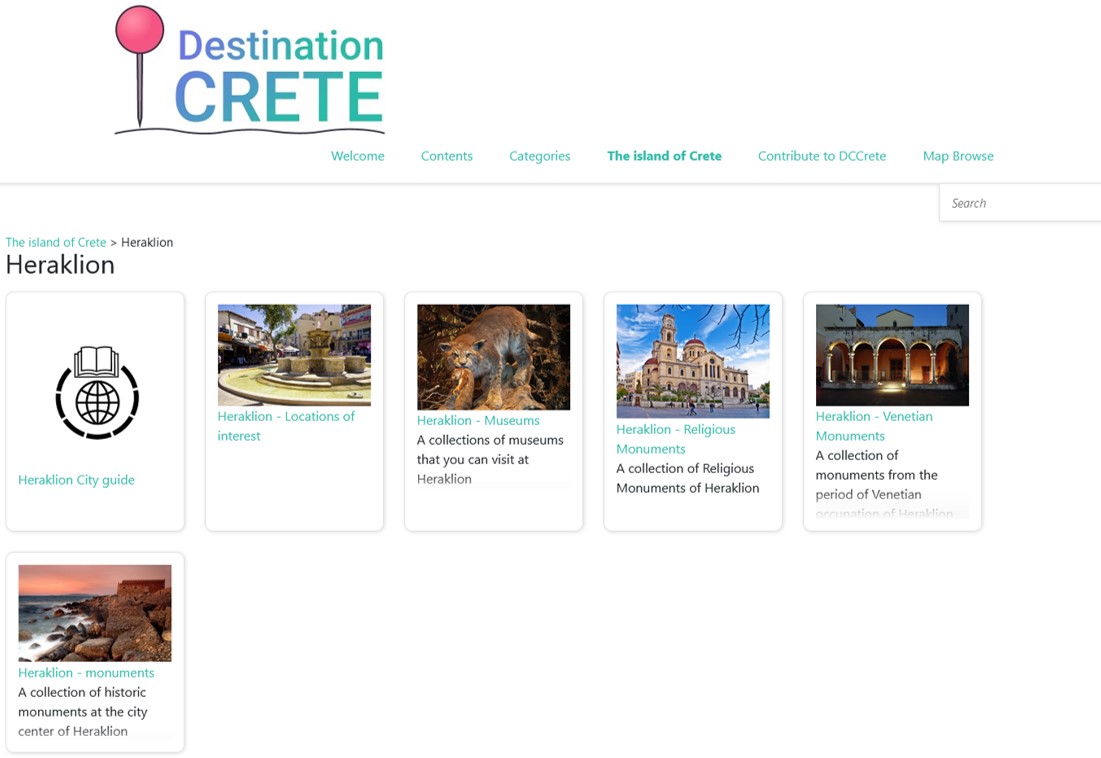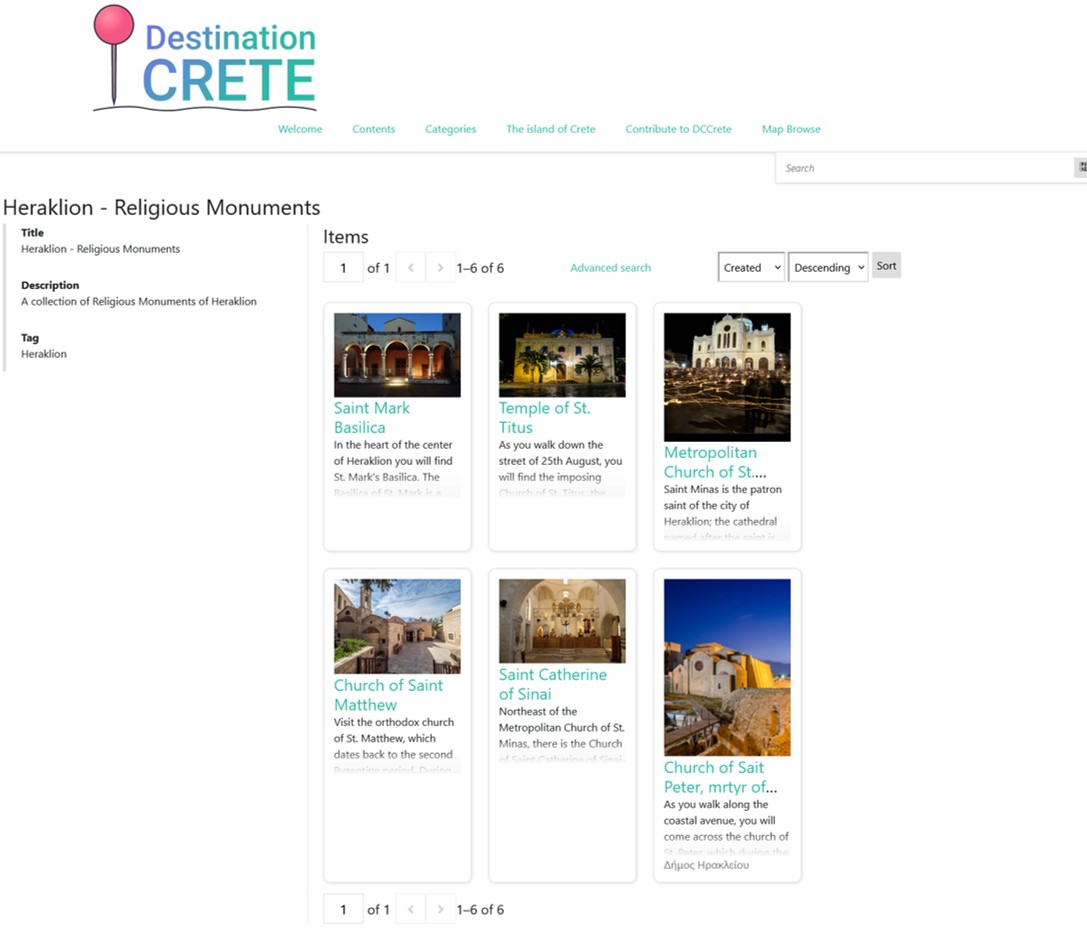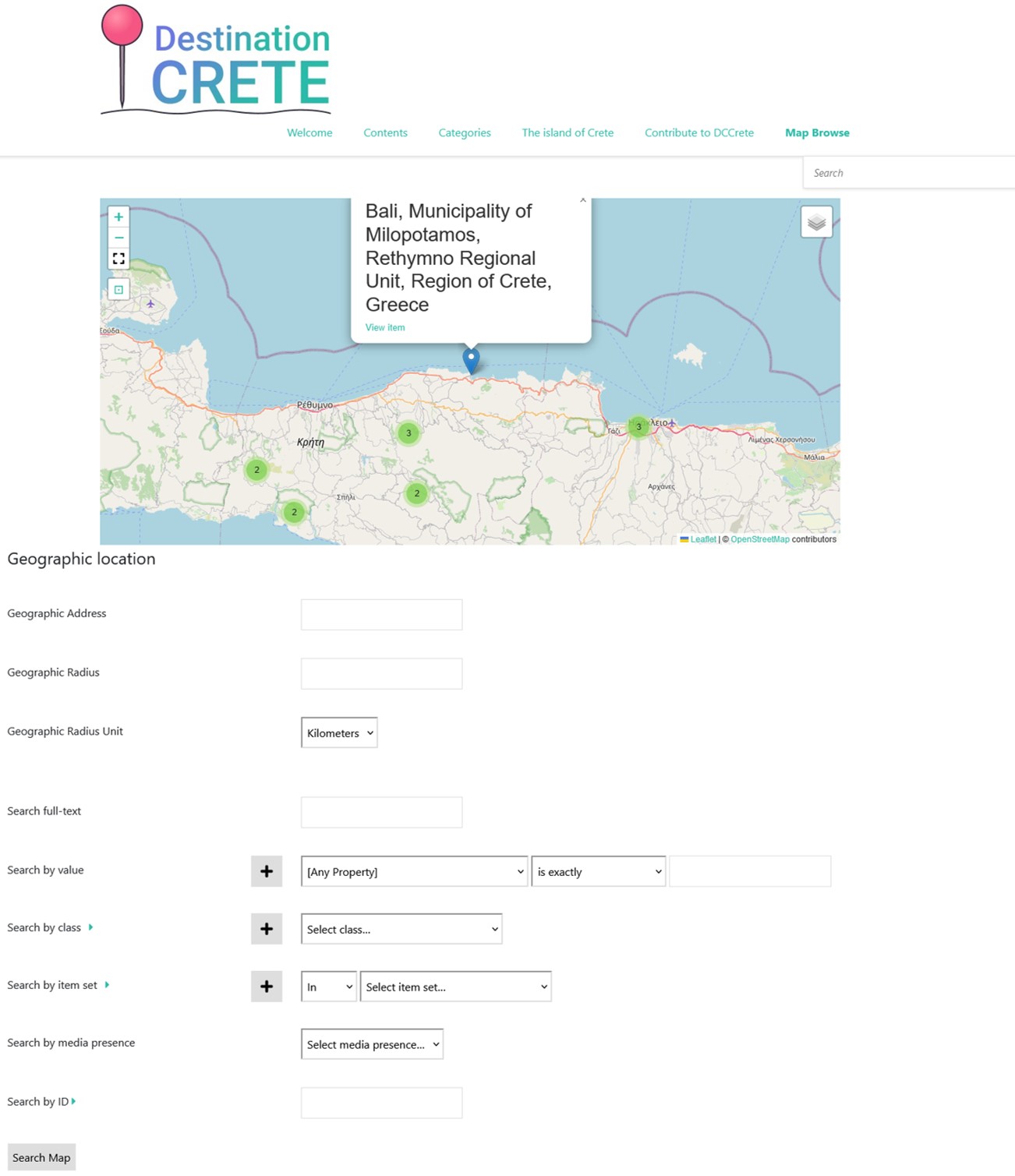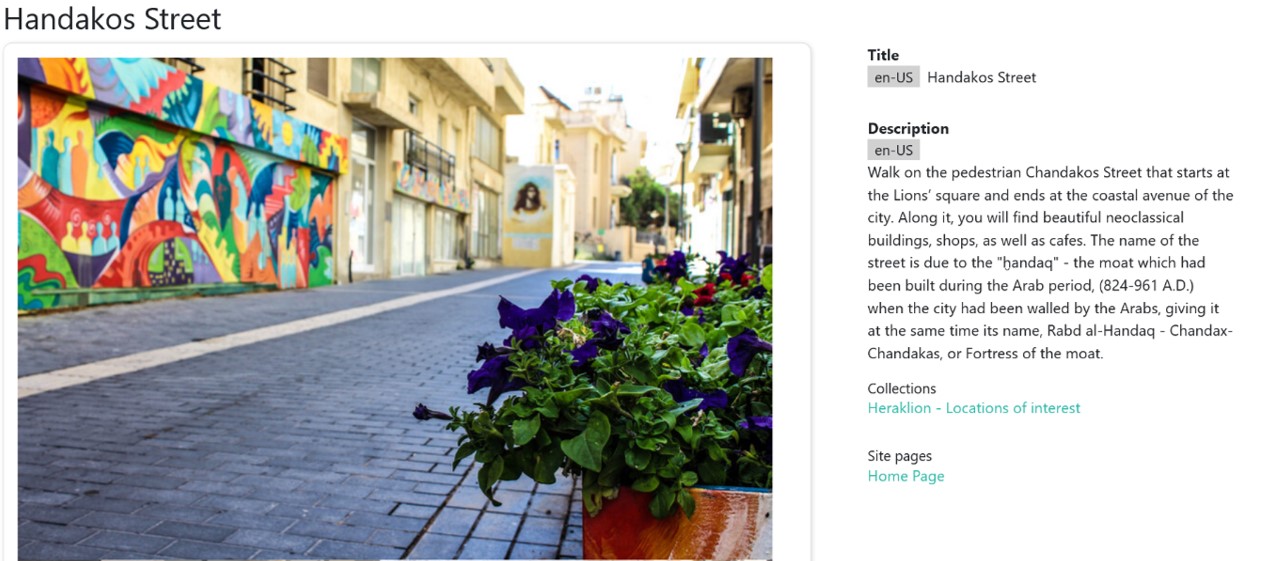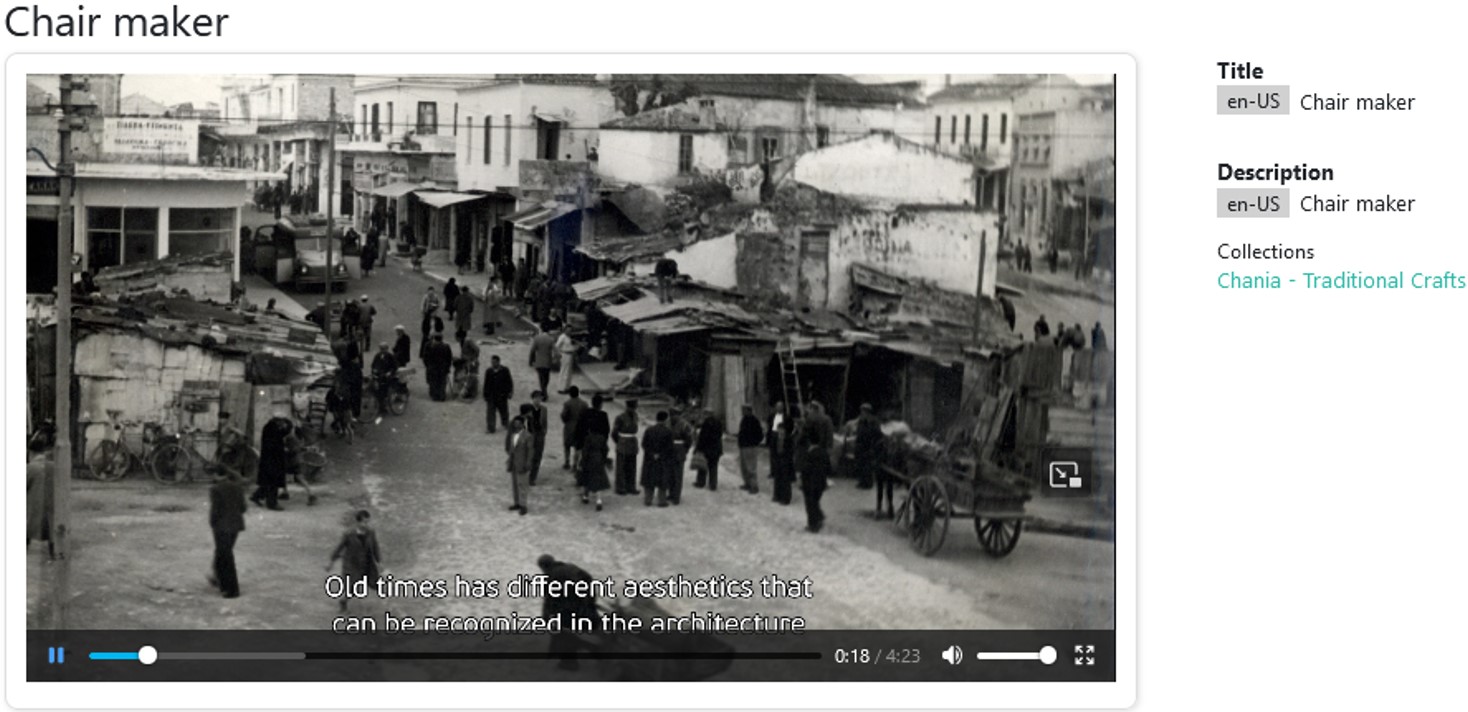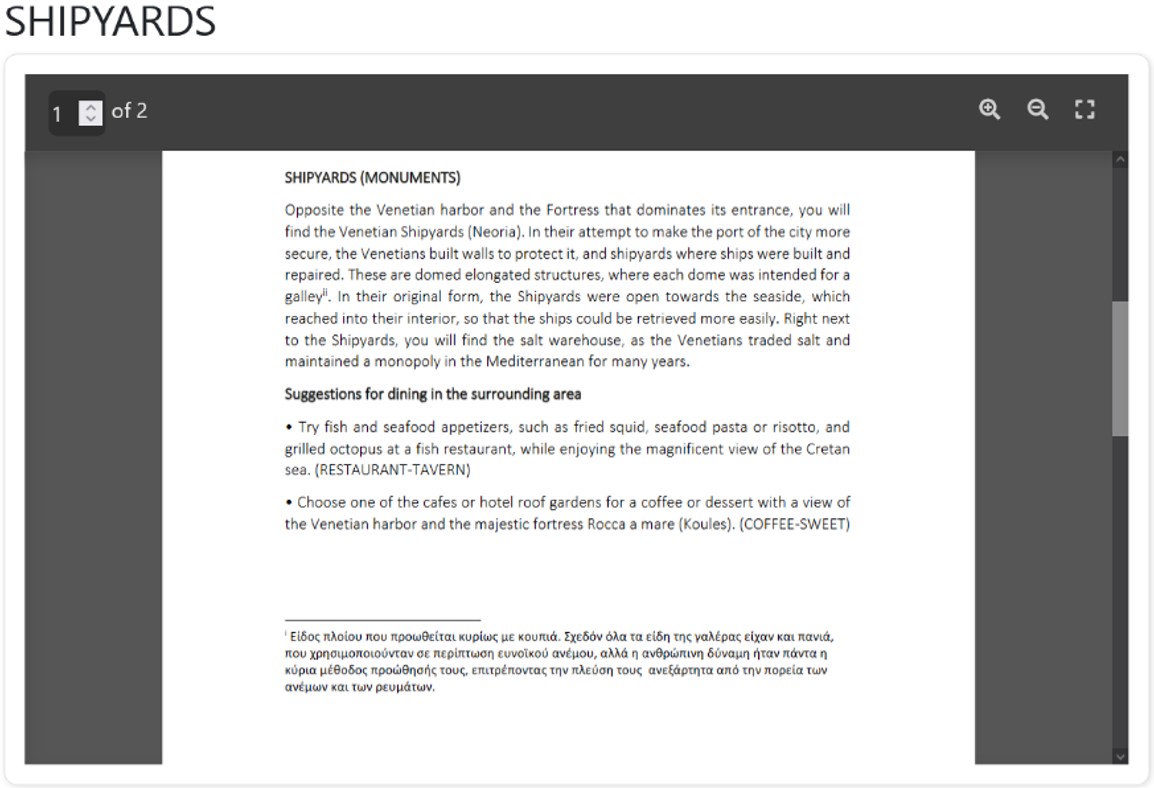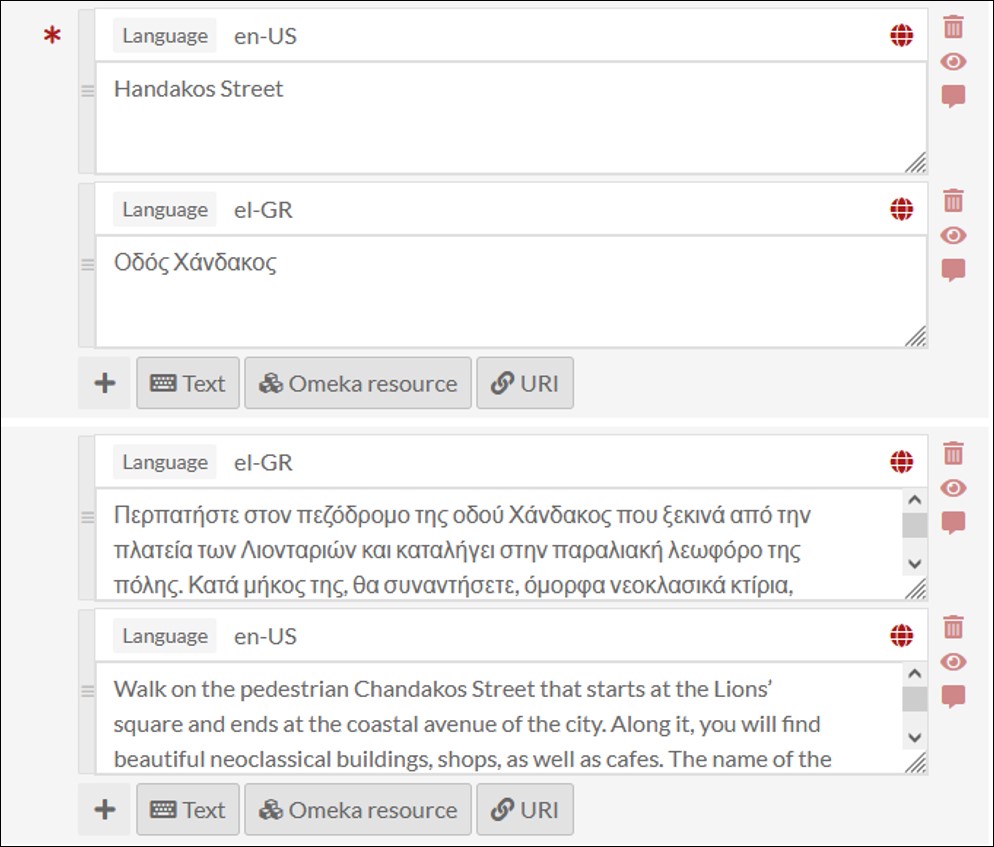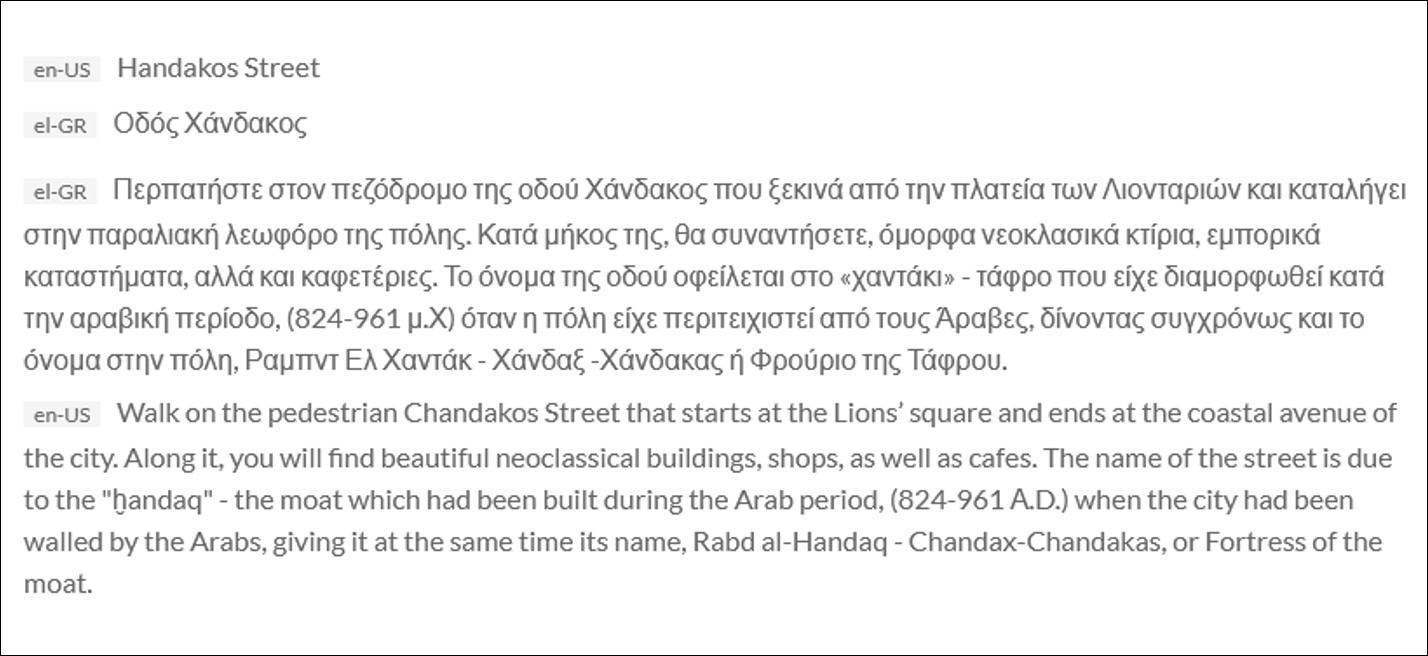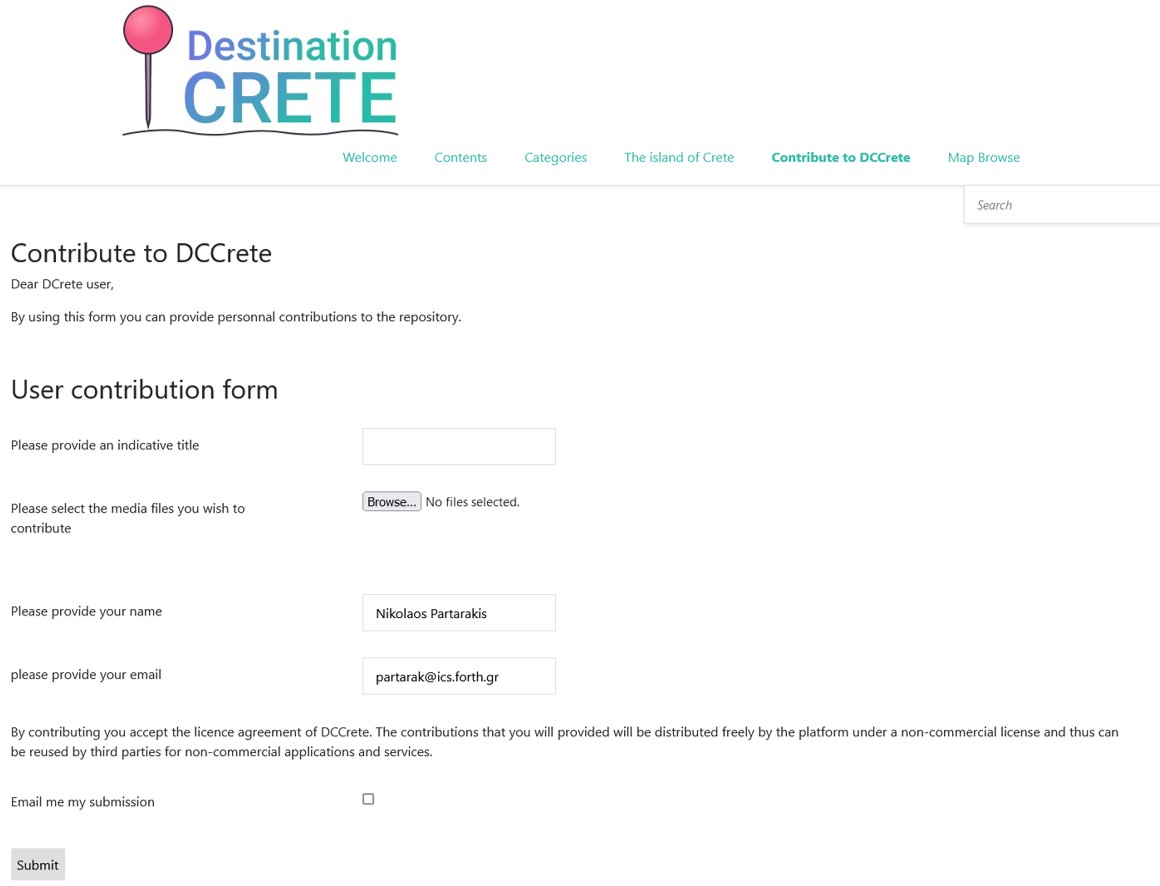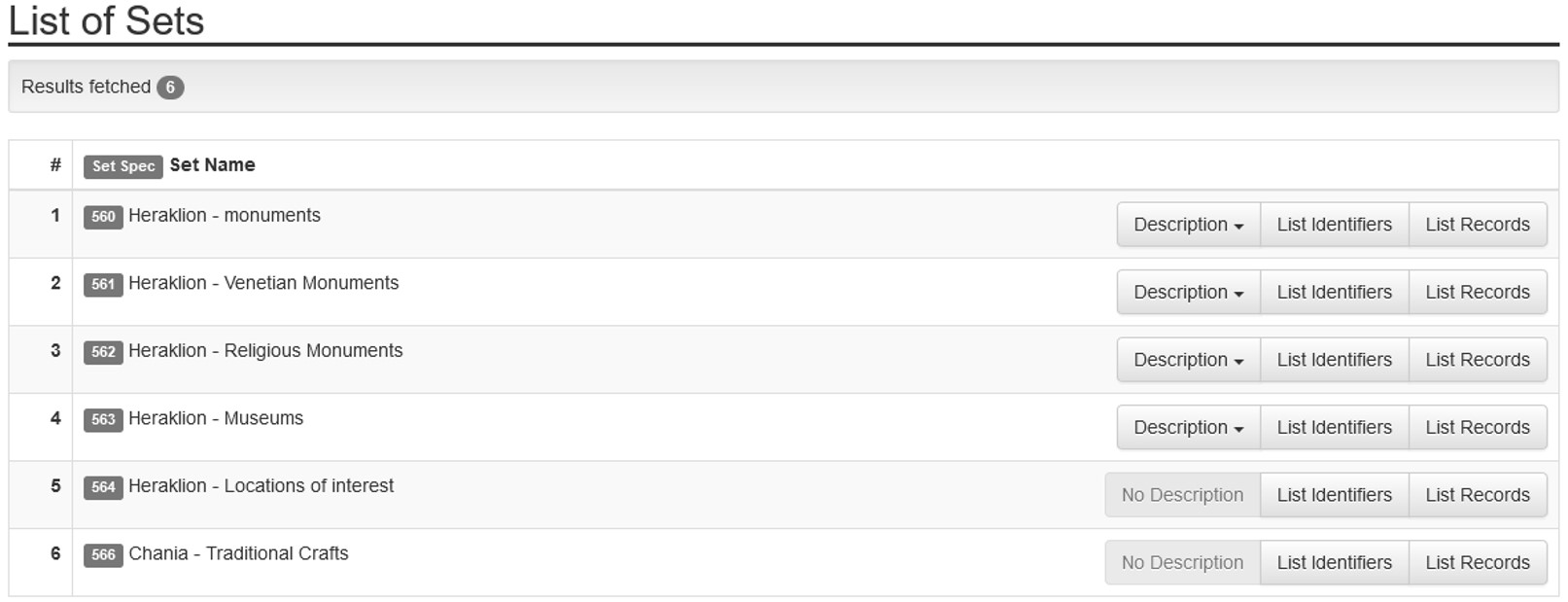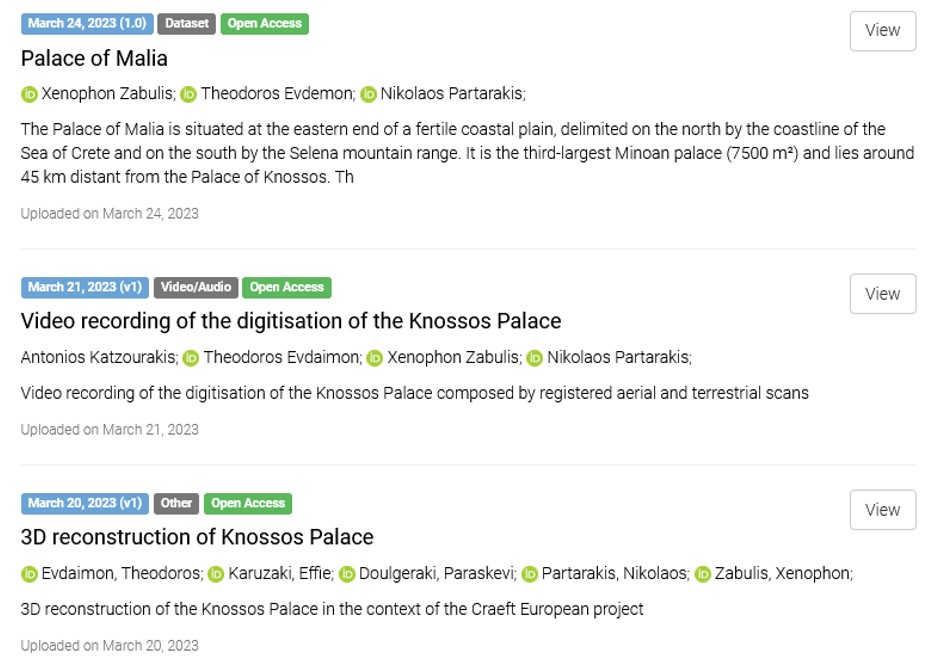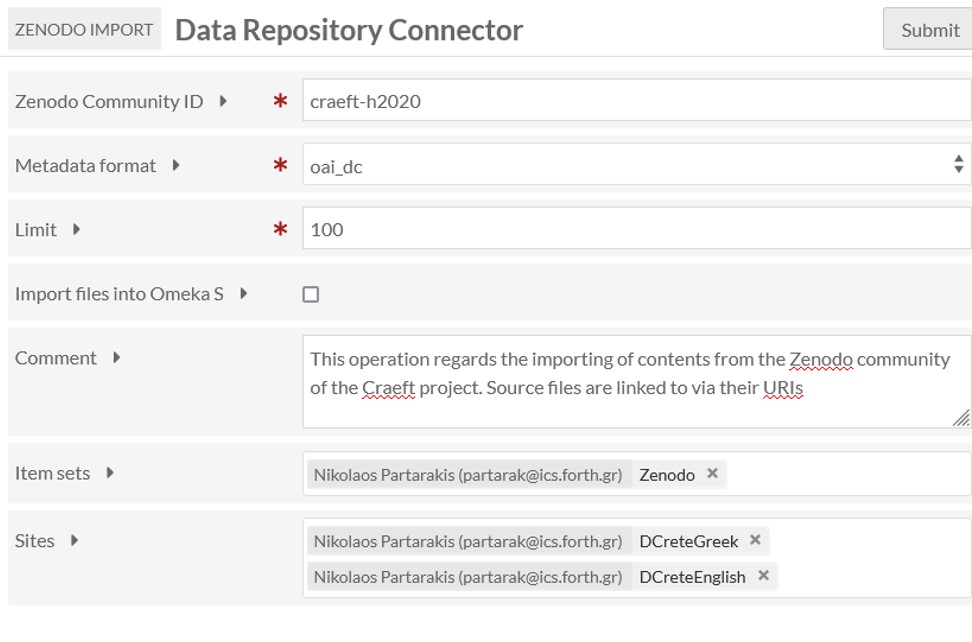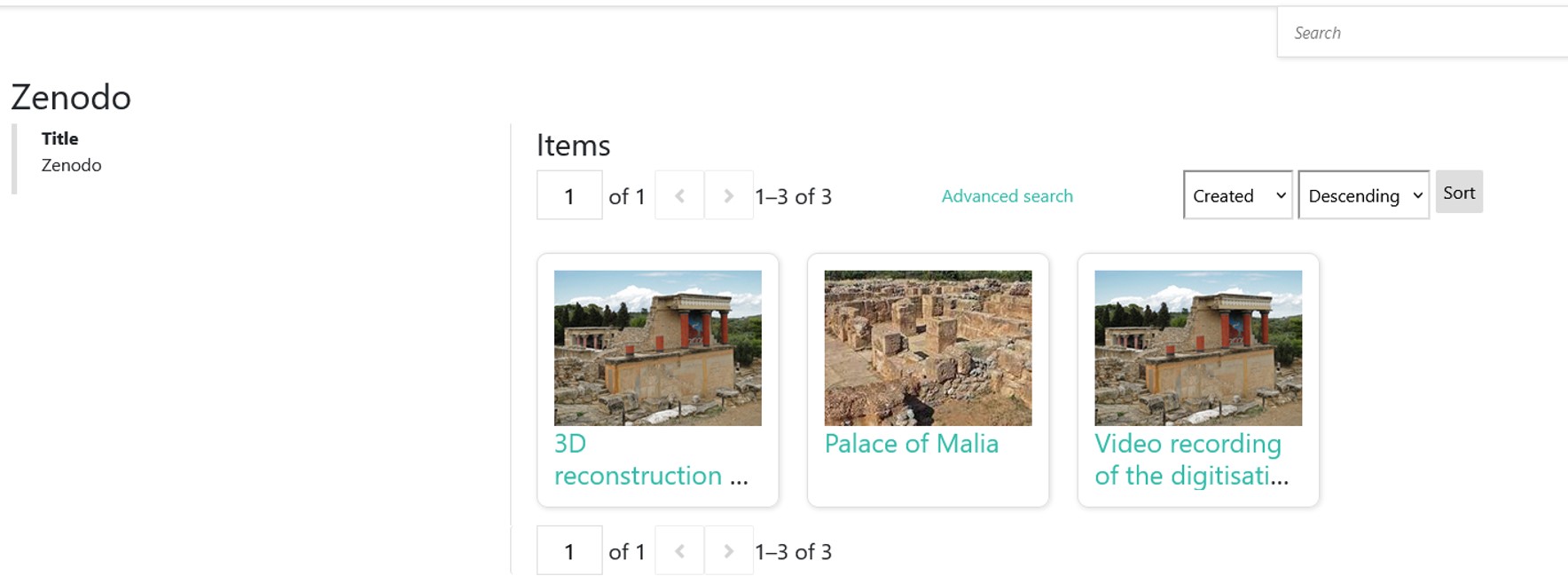Article Peer-Reviewed
An Open-data Repository for Sustainable Tourism
Nikolaos Partarakis 1,* ,
Effrosini Karouzaki 1,
Stavroula Ntoa 1,
Anastasia Ntagianta 1,
Emmanouil Zidianakis 1 and
Constantine Stephanidis 1,2
1
Institute of Computer Science, Foundation for Research and Technology – Hellas (FORTH), 70013 Heraklion, Crete, Greece
2
Computer Science Department, School of Sciences & Engineering, University of Crete, 70013 Heraklion, Crete, Greece
*
For correspondence.
Received: 7 June 2023 Accepted: 19 July 2023 Published: 21 July 2023
This article is part of the Special Issue Sustainable Tourism.
Abstract
This work outlines the benefits of an open repository of cultural and touristic content for promoting sustainability in tourism. The repository aims at sharing digital content with individuals, local communities, businesses, and tour operators to promote responsible tourism practices. By providing access to cultural and touristic content, the repository can increase awareness of local customs, traditions, and practices. This can promote respect for local culture and help reduce negative impacts on the environment and local communities. The repository also aims to promote off-season travel, which can reduce the strain on local infrastructure and support sustainable tourism practices. Additionally, it can reduce the need for physical souvenirs, which can contribute to waste and pollution. Through the sharing of digital content, the repository can support local communities and businesses by promoting their culture and heritage. This can help generate interest in the destination and support sustainable tourism development. To this end, the design and implementation of the technical infrastructure for such a repository are presented to act as an information system that is available online and contributes to sustainable development. The use case used for its demonstration facilitates cultural material from the region of Crete.
Figures in this Article
Keywords
Copyright © 2023
Partarakis et al. This article is distributed under the terms of the Creative Commons Attribution License (CC BY 4.0), which permits unrestricted use and distribution provided that the original work is properly cited.
Funding
This project has received funding from the RIS3-Crete programme of the National Strategic Reference Framework (NSRF) 2014–2020 of Greece which is co-financed by the European Union.
Cite this Article
Partarakis, N., Karouzaki, E., Ntoa, S., Ntagianta, A., Zidianakis, E., & Stephanidis, C. (2023). An Open-data Repository for Sustainable Tourism. Highlights of Sustainability, 2(3), 138–156. https://doi.org/10.54175/hsustain2030011
References
1.
Jenkins, I., & Schröder, R. (Eds.). (2013). Sustainability in tourism: A multidisciplinary approach. Springer. https://doi.org/10.1007/978-3-8349-7043-5
2.
Tosun, C. (1998). Roots of unsustainable tourism development at the local level: The case of Urgup in Turkey. Tourism Management, 19(6), 595–610. https://doi.org/10.1016/S0261-5177(98)00068-5
3.
Riasi, A., & Pourmiri, S. (2016). Examples of unsustainable tourism in Middle East. Environmental Management and Sustainable Development, 5(1), 69–85. https://doi.org/10.5296/emsd.v5i1.8705
4.
Davis, J. S., & Morais, D. B. (2004). Factions and enclaves: Small towns and socially unsustainable tourism development. Journal of Travel Research, 43(1), 3–10. https://doi.org/10.1177/0047287504265501
5.
Christensen, L. (2016). Environmental impact of long distance travel. Transportation Research Procedia, 14, 850–859. https://doi.org/10.1016/j.trpro.2016.05.033
6.
Hu, C., Liang, M., & Wang, X. (2023). Achieving green tourism through environmental perspectives of green digital technologies, green innovation, and green HR practices. Environmental Science and Pollution Research, 30, 73321–73334. https://doi.org/10.1007/s11356-023-27254-0
7.
Cabezuelo, A. S. (2020). Exploitation of open data repositories for the creation of value-added services. In F. Herrera, K. Matsui, & S. Rodríguez-González (Eds.), Distributed Computing and Artificial Intelligence, 16th International Conference. DCAI 2019. Advances in Intelligent Systems and Computing (pp. 134–141). Springer, Cham. https://doi.org/10.1007/978-3-030-23887-2_16
8.
Cabezuelo, A. S. (7–11 September 2020). Using open data repositories and geolocation to create value-added services for tourism. The 2020 24th International Conference Information Visualisation (IV), Melbourne, Australia. https://doi.org/10.1109/IV51561.2020.00030
9.
Pesonen, J., & Lampi, M. (2016). Utilizing open data in tourism. Information and Communication Technologies in Tourism, 1–5.
10.
Cao, T.-D., Nguyen, Q.-M., Nguyen, A.-D., & Le, T.-H. (2011). Integrating open data and generating travel itinerary in semantic-aware tourist information system. In Proceedings of the 13th International Conference on Information Integration and Web-based Applications and Services (pp. 214–221). Association for Computing Machinery. https://doi.org/10.1145/2095536.2095573
11.
Fermoso, A. M., Mateos, M., Beato, M. E., & Berjón, R. (2015). Open linked data and mobile devices as e-tourism tools. A practical approach to collaborative e-learning. Computers in Human Behavior, 51(Part B), 618–626. https://doi.org/10.1016/j.chb.2015.02.032
12.
Vert, S., & Vasiu, R. (2014). Relevant aspects for the integration of linked data in mobile augmented reality applications for tourism. In G. Dregvaite & R. Damasevicius (Eds.), Information and Software Technologies. ICIST 2014. Communications in Computer and Information Science (pp. 334–345). Springer, Cham. https://doi.org/10.1007/978-3-319-11958-8_27
13.
Mathioudakis, G., Klironomos, I., Partarakis, N., Papadaki, E., Anifantis, N., Antona, M., et al. (2021). Supporting Online and On-Site Digital Diverse Travels. Heritage, 4(4), 4558–4577. https://doi.org/10.3390/heritage4040251
14.
Mathioudakis, G., Klironomos, I., Partarakis, N., Papadaki, E., Volakakis, K., Anifantis, N., et al. (2022). InCulture: A Collaborative Platform for Intangible Cultural Heritage Narratives. Heritage, 5(4), 2881–2903. https://doi.org/10.3390/heritage5040149
15.
Longhi, C., Titz, J.-B., & Viallis, L. (2014). Open data: Challenges and opportunities for the tourism industry. In M.M. Mariani, R. Baggio, D. Buhalis, & C. Longhi (Eds.), Tourism Management, Marketing, and Development (Vol. I, pp. 57–76). Palgrave Macmillan. https://doi.org/10.1057/9781137354358_4
16.
Papapanos, G., Karampela, G. S., Kopsachilis, G. V., Vaitis, G. M., Kizos, T., & Spilanis, G. I. (2013). A Digital Repository for Managing Tourism on Islands. In I Foro Internacional de Turismo Maspalomas Costa Canaria (FITMCC 2013) - Congreso internacional de destinos turísticos: competitividad y emprendimiento en tiempos de crisis. Servicio de Publicaciones y Difusión Científica de la Universidad de Las Palmas de Gran Canaria (ULPGC).
17.
Kalaitzakis, M., Sykianaki, E., Michalakis, N., Stivaktakis, N., Balafa, K., Ntoa, S., et al. (2022). People-Flows: An innovative flow monitoring and management system in urban environments. In C. Stephanidis, M. Antona, S. Ntoa, & G. Salvendy (Eds.), HCI International 2022 – Late Breaking Posters. HCII 2022. Communications in Computer and Information Science (pp. 507–516). Springer, Cham. https://doi.org/10.1007/978-3-031-19682-9_64
18.
Pereira, R. L., Sousa, P. C., Barata, R., Oliveira, A., & Monsieur, G. (2015). CitySDK Tourism API - building value around open data. Journal of Internet Services and Applications, 6, 24. https://doi.org/10.1186/s13174-015-0039-z
19.
Bruseker, G., Carboni, N., & Guillem, A. (2017). Cultural heritage data management: The role of formal ontology and CIDOC CRM. In M. Vincent, V. López-Menchero Bendicho, M. Ioannides, & T. Levy (Eds.), Heritage and Archaeology in the Digital Age. Quantitative Methods in the Humanities and Social Sciences (pp. 93–131). Springer, Cham.
20.
Haslhofer, B., & Isaac, A. (21–23 September 2011). data.europeana.eu: The europeana linked open data pilot. International Conference on Dublin Core and Metadata Applications 2011, The Hague, The Netherlands.
21.
Ziku, M. (2020). Digital Cultural Heritage and Linked Data: Semantically-informed conceptualisations and practices with a focus on intangible cultural heritage. Liber Quarterly: The Journal of the Association of European Research Libraries, 30(1), 1–16. https://doi.org/10.18352/lq.10315
22.
Lin, C.-H., Hong, J.-S., & Doerr, M. (2008). Issues in an inference platform for generating deductive knowledge: A case study in cultural heritage digital libraries using the CIDOC CRM. International Journal on Digital Libraries, 8, 115–132. https://doi.org/10.1007/s00799-008-0034-0
23.
Ruotsalo, T., & Hyvönen, E. (2007). An event-based approach for semantic metadata interoperability. In K. Aberer, K.-S. Choi, N. Noy, D. Allemang, K.-I. Lee, L. Nixon, J. Golbeck, P. Mika, D. Maynard, R. Mizoguchi, G. Schreiber, & P. Cudré-Mauroux (Eds.), The Semantic Web. ISWC ASWC 2007 2007. Lecture Notes in Computer Science (pp. 409–422). Springer, Berlin, Heidelberg. https://doi.org/10.1007/978-3-540-76298-0_30
24.
Tudhope, D., Binding, C., May, K., & Charno, M. (26 September 2013). Pattern based mapping and extraction via CIDOC CRM. The Workshop Practical Experiences with CIDOC CRM and its Extensions (CRMEX 2013), 17th International Conference on Theory and Practice of Digital Libraries (TPDL 2013), Valetta, Malta.
25.
Damiano, R., Lieto, A., & Lombardo, V. (2–4 July 2014). Ontology-based visualisation of cultural heritage. The 2014 Eighth International Conference on Complex, Intelligent and Software Intensive Systems, Birmingham, UK. https://doi.org/10.1109/CISIS.2014.81
26.
Kalvet, T., Olesk, M., Tiits, M., & Raun, J. (2020). Innovative tools for tourism and cultural tourism impact assessment. Sustainability, 12(18), 7470. https://doi.org/10.3390/su12187470
27.
Doerr, M. (2003). The CIDOC conceptual reference module: an ontological approach to semantic interoperability of metadata. AI Magazine, 24(3), 75. https://doi.org/10.1609/aimag.v24i3.1720
28.
Partarakis, N. N., Doulgeraki, P. P., Karuzaki, E. E., Adami, I. I., Ntoa, S. S., Metilli, D. D., et al. (2021). Representation of socio-historical context to support the authoring and presentation of multimodal narratives: The Mingei Online Platform. Journal on Computing and Cultural Heritage, 15(1), 1–26. https://doi.org/10.1145/3465556
29.
Partarakis, N., Kaplanidi, D., Doulgeraki, P., Karuzaki, E., Petraki, A., Metilli, D., et al. (2021). Representation and presentation of culinary tradition as cultural heritage. Heritage, 4(2), 612–640. https://doi.org/10.3390/heritage4020036
30.
Partarakis, N., Doulgeraki, V., Karuzaki, E., Galanakis, G., Zabulis, X., Meghini, C., et al. (2022). A Web-Based Platform for Traditional Craft Documentation. Multimodal Technologies and Interaction, 6(5), 37. https://doi.org/10.3390/mti6050037
31.
Omeka. (2023). Omeka - Open-source web publishing platforms for sharing digital collections and creating media-rich online exhibits. https://omeka.org (accessed 10 May 2023).
32.
DSpace. (2023). The Software of Choice for Academic, Non-profit & Commercial Organizations Building Open Digital Repositories. https://www.dspace.org (accessed 13 May 2023).
33.
Fedora. (Year). Fedora is the flexible, modular, open source repository platform with native linked data support. https://fedora.info (accessed 5 May 2023).
34.
Islandora. (2023). Open-source Digital Asset Management. https://islandora.ca (accessed 5 May 2023).
35.
Giacomin, J. (2014). What is human centred design? The Design Journal, 17(4), 606–623. https://doi.org/10.2752/175630614X14056185480186
36.
Maguire, M. (2001). Methods to support human-centred design. International Journal of Human-Computer Studies, 55(4), 587–634. https://doi.org/10.1006/ijhc.2001.0503
37.
Maguire, M., & Bevan, N. (2002). User requirements analysis: a review of supporting methods. In Proceedings of the IFIP 17th World Computer Congress - TC13 Stream on Usability: Gaining a Competitive Edge (pp. 133–148). Springer, Boston.
38.
Wautelet, Y., Heng, S., Kolp, M., & Mirbel, I. (2014). Unifying and extending user story models. In International conference on advanced information systems engineering (pp. 211–225). Springer, Cham. https://doi.org/10.1007/978-3-319-07881-6_15
39.
Brown, T. (2008). Design thinking. Harvard Business Review, 86(6), 84.
40.
Leavitt, M. O., & Shneiderman, B. (2006). Research-based web design & usability guidelines. U.S. Health and Human Services Department.
41.
Instone, K. (1997). Usability heuristics for the Web. Web Review.
42.
Wu, M., Psomopoulos, F., Khalsa, S. J., & de Waard, A. (2019). Data discovery paradigms: User requirements and recommendations for data repositories. Data Science Journal, 18(3), 1–13. https://doi.org/10.5334/dsj-2019-003
43.
Kim, S. (2018). Functional requirements for research data repositories. International Journal of Knowledge Content Development & Technology, 8(1), 25–36.
44.
Lin, D., Crabtree, J., Dillo, I., Downs, R. R., Edmunds, R., Giaretta, D., et al. (2020). The TRUST Principles for digital repositories. Scientific Data, 7, 144. https://doi.org/10.1038/s41597-020-0486-7
45.
Wallis, J. C., Rolando, E., & Borgman, C. L. (2013). If we share data, will anyone use them? Data sharing and reuse in the long tail of science and technology. PLoS ONE, 8(7), e67332. https://doi.org/10.1371/journal.pone.0067332
46.
Janssen, M., Charalabidis, Y., & Zuiderwijk, A. (2012). Benefits, adoption barriers and myths of open data and open government. Information Systems Management, 29(4), 258–268. https://doi.org/10.1080/10580530.2012.716740
47.
Obrist, M., Geerts, D., Brandtzæg, P. B., & Tscheligi, M. (2008). Design for creating, uploading and sharing user generated content. In CHI’08 Extended Abstracts on Human Factors in Computing Systems (pp. 2391–2394). Association for Computing Machinery. https://doi.org/10.1145/1358628.1358692
48.
Ukpabi, D. C., & Karjaluoto, H. (2018). What drives travelers’ adoption of user-generated content? A literature review. Tourism Management Perspectives, 28, 251–273. https://doi.org/10.1016/j.tmp.2018.03.006
49.
Skinner, H. (2018). Who really creates the place brand? Considering the role of user generated content in creating and communicating a place identity. Communication and Society, 31(4), 9–24. https://doi.org/10.15581/003.31.4.9-24
50.
Cervi, L. (2019). Citizen Journalism and User Generated Content in Mainstream Media. New Dialogic Form of Communication, User-Engagement Technique or Free Labor Exploitation? Revista de Comunicação Dialógica, 1, 120–141. https://doi.org/10.12957/rcd.2019.41871
51.
Nielsen, L. (2013). Personas-user focused design (Vol. 1373). Springer London.
52.
Karanjit, A. (2016). MEAN vs. LAMP Stack [Master’s thesis, St. Cloud State University]. The Repository @ St. Cloud State. https://repository.stcloudstate.edu/csit_etds/11
53.
Linux.org. (2023). https://www.linux.org (accessed 1 April 2023).
54.
Apache. (2023). The Apache HTTP server project. https://httpd.apache.org (accessed 5 May 2023).
55.
Oracle. (2023). MySQL. https://www.mysql.com (accessed 7 February 2023).
56.
The PHP Group. (2023). PHP: Hypertext preprocessor. https://www.php.net (accessed 5 March 2023).
57.
Weibel, S., Kunze, J. A., Lagoze, C., & Wolf, M. (1998). Dublin core metadata for resource discovery (No. rfc2413). IETF Datatracker.
58.
McCallum, S. H. (2004). An introduction to the metadata object description schema (MODS). Library Hi Tech, 22(1), 82–88. https://doi.org/10.1108/07378830410524521
59.
Masse, M. (2011). REST API design rulebook: designing consistent RESTful web service interfaces. O’Reilly Media.
60.
Allen, R., Lo, N., & Brown, S. (2009). Zend framework in action. Manning.
61.
Hammer-Lahav, E. (2010). The oauth 1.0 protocol (No. rfc5849). IETF Datatracker.
62.
Van de Sompel, H., Nelson, M. L., Lagoze, C., & Warner, S. (2004). Resource harvesting within the OAI-PMH framework. D-Lib Magazine, 10(12), 1–18. https://doi.org/10.1045/december2004-vandesompel
63.
Meghini, C., Bartalesi, V., & Metilli, D. (2021). Representing narratives in digital libraries: The narrative ontology. Semantic Web, 12(2), 241–264.
64.
Metilli, D., Bartalesi, V., & Meghini, C. (2019). A Wikidata-based tool for building and visualising narratives. International Journal on Digital Libraries, 20, 417–432. https://doi.org/10.1007/s00799-019-00266-3
65.
Bartalesi, V., Meghini, C., & Metilli, D. (2017). A conceptualisation of narratives and its expression in the CRM. International Journal of Metadata, Semantics and Ontologies, 12(1), 35–46. https://doi.org/10.1504/IJMSO.2017.087692
66.
Bartalesi, V., Lenzi, E., & Pratelli, N. (2023). A Web Tool to Create and Visualise Semantic Story Maps. In R. Campos, A. Jorge, A. Jatowt, S. Bhatia, & M. Litvak (Eds.), Proceedings of the Text2Story’23 Workshop. CEUR-WS.
Metrics
Loading...
Journal Menu
Journal Contact
Highlights of Sustainability
Editorial Office
Highlights of Science
Avenida Madrid, 189-195, 3-3
08014 Barcelona, Spain
08014 Barcelona, Spain
Cathy Wang
Managing Editor
